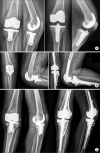Revision total knee arthroplasty with a cemented posterior stabilized, condylar constrained or fully constrained prosthesis: a minimum 2-year follow-up analysis
- PMID: 20514269
- PMCID: PMC2867196
- DOI: 10.4055/cios.2010.2.2.112
Revision total knee arthroplasty with a cemented posterior stabilized, condylar constrained or fully constrained prosthesis: a minimum 2-year follow-up analysis
Abstract
Background: The clinical and radiological outcomes of revision total knee arthroplasty with a cemented posterior stabilized (PS), condylar constrained knee (CCK) or a fully constrained rotating hinge knee (RHK) prosthesis were evaluated.
Methods: This study reviewed the clinical and radiological results of 36 revision total knee arthroplasties with a cemented PS, CCK, and RHK prosthesis in 8, 25, and 13 cases, respectively, performed between 1998 and 2006. The mean follow-up period was 30 months (range, 24 to 100 months). The reason for the revision was aseptic loosening of one or both components in 15, an infected total knee in 18 and a periprosthetic fracture in 3 knees. The average age of the patients at the time of the revision was 65 years (range, 58 to 83 years). The original diagnosis for all primary total knee arthroplasties was osteoarthritis except for one case of a Charcot joint. All revision prostheses were fixed with cement. The bone deficiencies were grafted with a cancellous allograft in the contained defect and cortical allograft fixed with a plate and screws in the noncontained defect. A medial gastrocnemius flap was needed to cover the wound dehiscence in 6 of the 18 infected cases.
Results: The mean Knee Society knee score improved from 28 (range, 5 to 43) to 83 (range, 55 to 94), (p < 0.001) and the mean Knee Society function score improved from 42 (range, 10 to 66) to 82 (range, 60 to 95), (p < 0.001) at the final follow-up. Good or excellent outcomes were obtained in 82% of knees. There were 5 complications (an extensor mechanism rupture in 3 and recurrence of infection in 2 cases). Three cases of an extensor mechanism defect (two ruptures of ligamentum patellae and one patellectomy) were managed by the RHK prosthesis to provide locking stability in the heel strike and push off phases, and two cases of recurrent infection used an antibiotic impregnated cement spacer. The radiological tibiofemoral alignment improved from 1.7 degrees varus to 3.0 degrees valgus in average. Radiolucent lines were observed in 18% of the knees without progressive osteolysis.
Conclusions: Revision total knee requires a more constrained prosthesis than primary total knee arthroplasty because of the ligamentous instability and bony defect. This short to midterm follow-up analysis demonstrated that a well planned and precisely executed revision can reduce pain and improve the knee function significantly. Infected cases showed as good a result as those with aseptic loosening through the use of antibiotics-impregnated cement beads and proper soft tissue coverage with a medial gastrocnemius flap.
Keywords: Prosthesis design; Revision; Total knee replacement; Treatment outcome.
Conflict of interest statement
No potential conflict of interest relevant to this article was reported.
Figures



Similar articles
-
Revision total knee arthroplasty with a cemented posterior-stabilized or constrained condylar prosthesis: a minimum 3-year and average 5-year follow-up study.J Arthroplasty. 1997 Dec;12(8):896-903. doi: 10.1016/s0883-5403(97)90159-5. J Arthroplasty. 1997. PMID: 9458255
-
Satisfactory mid-term outcomes of condylar-constrained knee implants in primary total knee arthroplasty: clinical and radiological follow-up.J Orthop Traumatol. 2020 Dec 2;21(1):22. doi: 10.1186/s10195-020-00561-9. J Orthop Traumatol. 2020. PMID: 33263831 Free PMC article.
-
Hinged versus CCK revision arthroplasty for the stiff total knee.Knee. 2019 Jan;26(1):222-227. doi: 10.1016/j.knee.2018.10.012. Epub 2018 Nov 8. Knee. 2019. PMID: 30415974
-
Rate of complications and short-term Functional Results of Revision Total Knee Arthroplasty for Tibio-femoral Instability: do stability and range of motion are restored in 62 revisions.Orthop Traumatol Surg Res. 2025 Feb;111(1):103986. doi: 10.1016/j.otsr.2024.103986. Epub 2024 Sep 4. Orthop Traumatol Surg Res. 2025. PMID: 39241908 Review.
-
Constrained Implants in Total Knee Replacement.Surg Technol Int. 2015 May;26:307-16. Surg Technol Int. 2015. PMID: 26055025 Review.
Cited by
-
A clinical study of the rotational alignment of the femoral component in total knee arthroplasty.J Phys Ther Sci. 2015 Jul;27(7):2077-81. doi: 10.1589/jpts.27.2077. Epub 2015 Jul 22. J Phys Ther Sci. 2015. PMID: 26311929 Free PMC article.
-
Constraint degree in revision total knee replacement: a registry study on 1432 patients.Musculoskelet Surg. 2024 Jun;108(2):195-200. doi: 10.1007/s12306-023-00790-1. Epub 2023 May 26. Musculoskelet Surg. 2024. PMID: 37237144 Free PMC article.
-
Constraint choice in revision knee arthroplasty.Int Orthop. 2013 Jul;37(7):1279-84. doi: 10.1007/s00264-013-1929-y. Epub 2013 May 23. Int Orthop. 2013. PMID: 23700251 Free PMC article.
-
Postoperative Alignment in Hinge Total Knee Arthroplasty - "Are Hinge Knees too Valgus?".Iowa Orthop J. 2025;45(1):75-79. Iowa Orthop J. 2025. PMID: 40606690 Free PMC article.
-
Outcome of knee revisions for osteoarthritis and inflammatory arthritis with postero-stabilized arthroplasties: a mean ten-year follow-up with 90 knee revisions.Int Orthop. 2017 Apr;41(4):757-763. doi: 10.1007/s00264-016-3319-8. Epub 2016 Oct 27. Int Orthop. 2017. PMID: 27787574
References
-
- Ranawat CS, Flynn WF, Jr, Deshmukh RG. Impact of modern technique on long-term results of total condylar knee arthroplasty. Clin Orthop Relat Res. 1994;(309):131–135. - PubMed
-
- Ahlberg A, Lunden A. Secondary operations after knee joint replacement. Clin Orthop Relat Res. 1981;(156):170–174. - PubMed
-
- Rand JA, Bryan RS. Revision after total knee arthroplasty. Orthop Clin North Am. 1982;13(1):201–212. - PubMed
-
- Cameron HU, Hunter GA. Failure in total knee arthroplasty: mechanisms, revisions, and results. Clin Orthop Relat Res. 1982;(170):141–146. - PubMed
-
- Goldberg VM, Figgie MP, Figgie HE, 3rd, Sobel M. The results of revision total knee arthroplasty. Clin Orthop Relat Res. 1988;(226):86–92. - PubMed
MeSH terms
LinkOut - more resources
Full Text Sources
Other Literature Sources
Medical

